An antipope is a person who claims to be Bishop of Rome and leader of the Catholic Church in opposition to the legitimately elected pope. Between the 3rd and mid-15th centuries, antipopes were supported by factions within the Church itself and secular rulers.
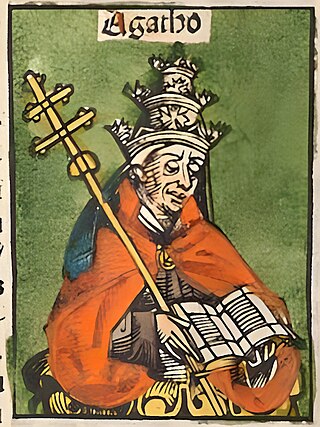
Pope Agatho served as the bishop of Rome from 27 June 678 until his death. He heard the appeal of Wilfrid of York, who had been displaced from his see by the division of the archdiocese ordered by Theodore of Canterbury. During Agatho's tenure, the Sixth Ecumenical Council was convened to deal with monothelitism. He is venerated as a saint by both the Catholic and Eastern Orthodox churches.

Pope Siricius was the bishop of Rome from December 384 to his death. In response to inquiries from Bishop Himerius of Tarragona, Siricius issued the Directa decretal, containing decrees of baptism, church discipline and other matters. His are the oldest completely preserved papal decretals. He is sometimes said to have been the first bishop of Rome to call himself pope.
Pope Stephen IV was the bishop of Rome and ruler of the Papal States from June 816 to his death. Stephen belonged to a noble Roman family. In October 816, he crowned Louis the Pious as emperor at Reims, and persuaded him to release some Roman political prisoners he held in custody. He returned to Rome, by way of Ravenna, sometime in November and died the following January.

Year 366 (CCCLXVI) was a common year starting on Sunday of the Julian calendar. At the time, it was known as the Year of the Consulship of Gratianus and Dagalaifus. The denomination 366 for this year has been used since the early medieval period, when the Anno Domini calendar era became the prevalent method in Europe for naming years.
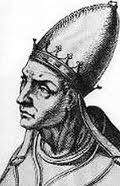
Pope Leo VIII was a Roman prelate who claimed the Holy See from 963 until 964 in opposition to John XII and Benedict V and again from 23 June 964 to his death. Today he is considered by the Catholic Church to have been an antipope during the first period and the legitimate Pope of Rome during the second. An appointee of Holy Roman Emperor Otto I, Leo VIII's pontificate occurred after the period known as the saeculum obscurum.
Pope Leo II was the bishop of Rome from 17 August 682 to his death. He is one of the popes of the Byzantine Papacy. Described by a contemporary biographer as both just and learned, he is commemorated as a saint in the Roman Martyrology on 28 June.
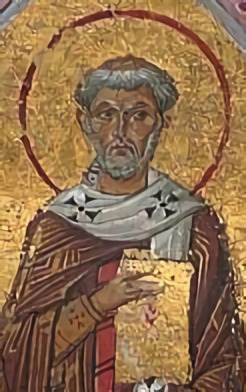
Pope Leo I, also known as Leo the Great, was Bishop of Rome from 29 September 440 until his death.
Pope Hilarius was the bishop of Rome from 19 November 461 to his death on 29 February 468.
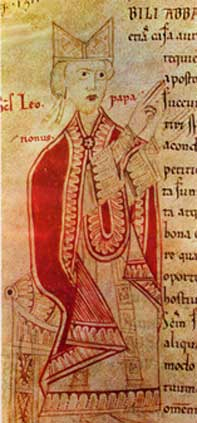
Pope Leo IX, born Bruno von Egisheim-Dagsburg, was the head of the Catholic Church and ruler of the Papal States from 12 February 1049 to his death in 1054. Leo IX is considered to be one of the most historically significant popes of the Middle Ages; he was instrumental in the precipitation of the Great Schism of 1054, considered the turning point in which the Catholic and Eastern Orthodox Churches formally separated.
Pope Vitalian was the bishop of Rome from 30 July 657 to his death. His pontificate was marked by the dispute between the papacy and the imperial government in Constantinople over Monothelitism, which Rome condemned. Vitalian tried to resolve the dispute and had a conciliatory relationship with Emperor Constans II, who visited him in Rome and gave him gifts. Vitalian's pontificate also saw the secession of the Archbishopric of Ravenna from the papal authority.

Flavian, sometimes Flavian I, was Archbishop of Constantinople from 446 to 449. He is venerated as a saint by the Eastern Orthodox Church and the Catholic Church.

The House of Montefeltro is the name of a historical Italian family who ruled Urbino and Gubbio and became Dukes of Urbino in 1443. The family extinguished in the male line in 1508 and the duchy was inherited by the Della Rovere family.
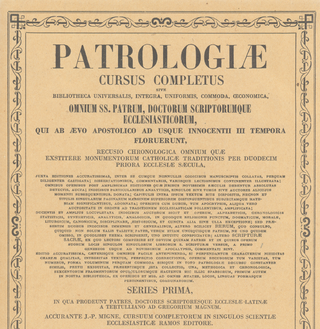
The Patrologia Latina is an enormous collection of the writings of the Church Fathers and other ecclesiastical writers published by Jacques-Paul Migne between 1841 and 1855, with indices published between 1862 and 1865. It is also known as the Latin series as it formed one half of Migne's Patrologiae Cursus Completus, the other part being the Patrologia Graeca of patristic and medieval Greek works with their medieval Latin translations.

The Diocese of San Marino-Montefeltro is a Latin Church ecclesiastical jurisdiction or diocese of the Catholic Church in both Italy and San Marino. It is a suffragan in the ecclesiastical province of the metropolitan Archdiocese of Ravenna-Cervia. The current diocese includes all the parishes of San Marino.

The Archdiocese of Siracusa, also known as Syracuse, is a Latin Church ecclesiastical territory or diocese of the Catholic Church in Sicily. It became an archdiocese in 1844. The current archbishop is Francesco Lomanto.

The Archdiocese of Catania is a Latin Church diocese of the Catholic Church in Sicily, southern Italy, with its seat in Catania. It was elevated to an archdiocese in 1859, and became a metropolitan see in 2000. Its suffragans are the diocese of Acireale and the diocese of Caltagirone.
Heliodorus of Catania is a semi-legendary personage accused by his contemporaries of being a necromancer practicing witchcraft.
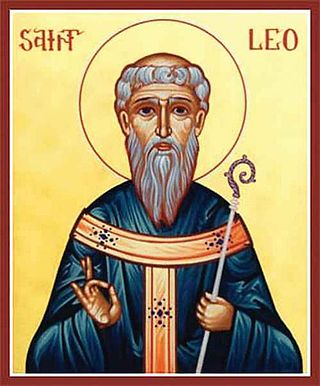
Saint Leo of Catania, nicknamed the Thaumaturgus, also known as St Leo the Wonderworker in Sicily, was the fifteenth bishop of Catania, famed also for his love and care toward the poor. His feast day occurs on 20 February, the day of his death in which he is venerated as a saint both by Roman Catholics and by the Orthodox Church. He lived in the lapse of time between the reigns of the Emperors Justinian II and Constantine VI. He struggled especially against the paganism and sorcery still prevalent in the Byzantine Sicily.
San Marino is a small landlocked country with an area of about 61.2 km2 (23.6 sq mi) on a rocky promontory at an elevation of 657 meters (2,156 ft) in central Italy. In 2023, the population was 33,636. It is the third smallest country in Europe after Vatican City and Monaco. It was founded as a Republic in 600 AD and recognized by the Papacy in 1631, and became a member of the United Nations in 1992. As of 2009, the ethnic composition is about 84.95% Sammarinese, 14.6% Italians and others.












